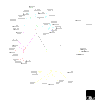The mitochondrial uncoupling proteins
- PMID: 12537581
- PMCID: PMC151194
- DOI: 10.1186/gb-2002-3-12-reviews3015
The mitochondrial uncoupling proteins
Abstract
The uncoupling proteins (UCPs) are transporters, present in the mitochondrial inner membrane, that mediate a regulated discharge of the proton gradient that is generated by the respiratory chain. This energy-dissipatory mechanism can serve functions such as thermogenesis, maintenance of the redox balance, or reduction in the production of reactive oxygen species. Some UCP homologs may not act as true uncouplers, however, and their activity has yet to be defined. The UCPs are integral membrane proteins, each with a molecular mass of 31-34 kDa and a tripartite structure in which a region of around 100 residues is repeated three times; each repeat codes for two transmembrane segments and a long hydrophilic loop. The functional carrier unit is a homodimer. So far, 45 genes encoding members of the UCP family have been described, and they can be grouped into six families. Most of the described genes are from mammals, but UCP genes have also been found in fish, birds and plants, and there is also functional evidence to suggest their presence in fungi and protozoa. UCPs are encoded in their mature form by nuclear genes and, unlike many nuclear-encoded mitochondrial proteins, they lack a cleavable mitochondrial import signal. The information for mitochondrial targeting resides in the first loop that protrudes into the mitochondrial matrix; the second matrix loop is essential for insertion of the protein into the inner mitochondrial membrane. UCPs are regulated at both the transcriptional level and by activation and inhibition in the mitochondrion.
Figures





References
-
- Solanes G, Vial-Puig A, Grujic D, Flier JS, Lowell BB. The human uncoupling protein-3 gene. J Biol Chem. 1997;272:25433–25436. Description of the structure of the UCP3 gene. - PubMed
-
- Walker JE, Runswick MJ. The mitochondrial transport protein superfamily. J Bioenerg Biomembr. 1993;25:435–446. A review that includes a description of the characteristic features of the protein superfamily formed by the mitochondrial transporters of metabolites. - PubMed
-
- PROSITE http://ca.expasy.org/prosite/ A database of protein families and domains.
Publication types
MeSH terms
Substances
LinkOut - more resources
Full Text Sources
Other Literature Sources

